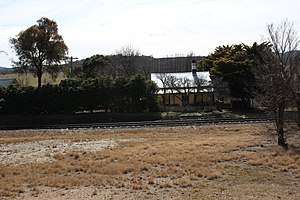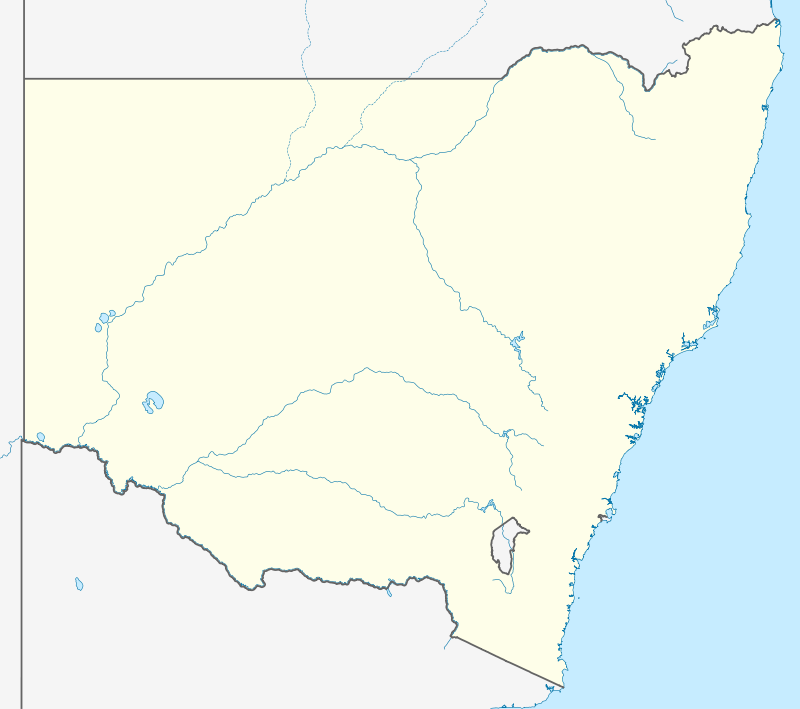Carwoola
Carwoola is a locality in the state of New South Wales, Australia.[5][6] It is immediately to the south of the Kowen district, which is located in the Australian Capital Territory. The Molonglo River passes through the Carwoola area before opening out into the Molonglo Plains. The Kings Highway and Captains Flat Road are the two major through routes. Carwoola is part of the Queanbeyan-Palerang Regional Council and the Southern Tablelands geographic area. The area also roughly aligns with the original Carwoola Parish.
| Carwoola New South Wales | |||||||||||||||
|---|---|---|---|---|---|---|---|---|---|---|---|---|---|---|---|
 Burbong station house. The railway station was closed in 1975. | |||||||||||||||
 Carwoola | |||||||||||||||
| Coordinates | 35°21′51″S 149°19′39″E | ||||||||||||||
| Population | 1,428 (2016 census)[1] | ||||||||||||||
| Postcode(s) | 2620 | ||||||||||||||
| Location | |||||||||||||||
| LGA(s) | Queanbeyan-Palerang Regional Council | ||||||||||||||
| County | Murray | ||||||||||||||
| Parish | Carwoola | ||||||||||||||
| State electorate(s) | Monaro | ||||||||||||||
| Federal Division(s) | Eden-Monaro | ||||||||||||||
| |||||||||||||||
Community
Carwoola has a Community Hall, managed by the local Community Association and a Rural Fire Brigade of the NSW Rural Fire Service (the Carwoola Brigade, formerly Stoney Creek Brigade) as well two public areas in Bowen Street and Molonglo River Drive.
Carwoola Landcare is also an active part of the Molonglo Catchment Group.
History
The first white men to come to the area arrived around 1820, and began to settle along the Molonglo Plains, arriving at the junction of the Molonglo and Queanbeyan Rivers on 8 December 1820.[7] Timothy Beard, a convict who had arrived in the Colony in 1805 and received his pardon in 1817, set up as an innkeeper on 100 acres of land near Campbelltown. In 1828 he "squatted" on the Molonglo River near where Canberra Abattoir was situated (now the industrial estate in the ACT suburb Beard).
The first authorised settler to reside on a large holding in the district was Owen Bowen (1778-1840), a convict who had arrived in the Colony on 2 July 1811, having sailed from Falmouth aboard the ship Providence. Bowen was freed from servitude at the age of 46 and secured a ticket of occupation for one hundred acres at Marlow Plains("Molonglo") in June 1824. Three years later he applied, unsuccessfully, for another grant at "Carrowillah" which was located three miles west of his holdings and eighteen miles from Lake George.
One of Owen Bowen’s neighbours, William Balcombe, was Colonial Treasurer from 1823 until his death in 1829. Balcombe had previously been an official of the East India Company at St Helena, and it was here that he befriended Napoleon Bonaparte during his exile. His friendship with Napoleon was considered so dangerous that he was eventually removed to NSW. On 5 August 1824, Governor Brisbane offered Balcombe a grant of 2,000 acres at Menanglo or Marlet Plains about eighteen miles southwest of Lake George. William Balcombe Snr called his property "The Briars" (after his estate of the same name on St Helena where Napoleon stayed for the first few weeks of his captivity) and built a slab home just below where the present stone cottages stand today. It is believed that William Snr was responsible for introducing two plants to Australia, the Sweet Briar (Rosa Rubiginosa) and the Weeping Willow (Salix Babylonica). The willow grew nearby Napoleon’s grave on St Helena and Balcombe is reported to have taken cuttings from these trees.
John Hosking (1806-1882) was owner of "Foxlow" station, which was named after his wife Martha Foxlow Terry, and settled on the estate around 1835. Hoskinstown is named after John Hosking, although it has undergone several nomenclature changes since its beginning. Hosking purchased "Foxlowe" previously known as Molonglo from Antill, Henry Colden (1779–1852). He established an estate at Primrose Valley which was to remain in the family until then. Antill was an Aide-de-Camp to Governor Macquarie and its believed he received the land as a grant.
Thomas Rutledge bought an estate on the Molonglo Plain in the mid-1800s and called it "Carwoola" from the aboriginal name of land first occupied by Owen Bowen. The aboriginal word was Carrowillah which means "where the water meets the plain".
Carwoola had a school between 1868 and 1871, 1873 and 1904, 1907 and 1910 and 1919 and 1924, usually operating as a "half-time" school, otherwise as a public or provisional school.[8] There was also a "half-time" school at Flannel Tree in southwestern Carwoola between 1910 and 1913 and between 1919 and 1923. During the latter period the two schools shared a teacher.[9]
Heritage listings
Carwoola has a number of heritage-listed sites, including:
- 1071 Captains Flat Road: Carwoola Homestead[10]
- Goulburn-Bombala railway: Burbong railway bridge[11]
Bushranging
The bushranger William Westwood, alias Jacky Jacky, was active in the Carwoola area, bailing up a victim at the 11-Mile turnoff in December 1840 after escaping from his convict servitude at the Gidleigh station, six kilometres east of Bungendore.[12]
Burbong station
A station was established on the Bombala railway line at the crossing of the Molonglo in 1887 and originally called Molonglo. In 1890, it was renamed Burbong and a small settlement developed there.[13] The station was closed in 1975.[14]
2017 bushfire
A bush-fire that began on 17 February 2017 destroyed 11 homes in the town and burned out 3,500 hectares (8,600 acres). 45 outbuildings were destroyed and another 40 damaged,[15] with 25 vehicles and 150 km of fencing also destroyed.[16] Very few livestock were lost, despite initial reports of severe losses.[17][18] 2 firefighters were injured, 1 suffering burns. The other firefighter sustained a crush injury when fire tankers were being moved.[18] The number of houses destroyed was subsequently revised down to 8.[19]
Two men were charged in July 2017 with "..failing to comply with a total fire ban and setting fire to another's property." In court on 2 September, their lawyers said they would plead not guilty.[20]
In early August 2017 a class action for residents affected by the fires was begun by Maddens Lawyers of Victoria.[21]
References
- Australian Bureau of Statistics (27 June 2017). "Carwoola (State Suburb)". 2016 Census QuickStats. Retrieved 16 July 2017.

- "Great Circle Distance between CARWOOLA and SYDNEY". Geoscience Australia. Retrieved 18 February 2017.
- "Great Circle Distance between CARWOOLA and QUEANBEYAN". Geoscience Australia. Retrieved 18 February 2017.
- "Great Circle Distance between CARWOOLA and CANBERRA". Geoscience Australia. Retrieved 18 February 2017.
- "Carwoola". Geographical Names Register (GNR) of NSW. Geographical Names Board of New South Wales. Retrieved 29 July 2017.

- "Carwoola". OpenStreetMap. Retrieved 29 January 2018.
- Johnston, T.A. (1988). The Radcliffe Community Bicentennial Cook Book.
- "Carwoola school in the School history database search". New South Wales Department of Education. Retrieved 29 January 2018.
- "Flannel Tree school in the School history database search". New South Wales Department of Education. Retrieved 29 January 2018.
- "Carwoola Homestead". New South Wales State Heritage Register. Office of Environment and Heritage. H00036. Retrieved 18 May 2018.
- "Queanbeyan rail bridges over Queanbeyan and Burbong Rivers". New South Wales State Heritage Register. Office of Environment and Heritage. H01052. Retrieved 2 June 2018.
- Jauncey, Jim (April 1991). Stoney Creek Gazette. 2 (4). Missing or empty
|title=(help) - "Burbong". Geographical Names Register (GNR) of NSW. Geographical Names Board of New South Wales. Retrieved 3 August 2017.

- "Burbong". NSWRail.net. Retrieved 3 August 2017.
- Le Lievre, Kimberley; Groch, Sherryn; Brown, Andrew (18 February 2017). "Police investigate blaze near Queanbeyan as fire crews battle on". The Canberra Times. Archived from the original on 21 February 2017. Retrieved 21 February 2017.
- Ted O'Kane (7 April 2017). "Up close and personal - Lessons from the Carwoola fire". The Land. Retrieved 13 November 2019.
- Kimberley Le Lievre (10 February 2018). "Carwoola fires one year on as "an apocalyptic situation" remembered". Canberra Times. Retrieved 13 November 2019.
- "Men to face court over destructive Carwoola fire". ABC News. Australian Broadcasting Corporation. 6 July 2017. Retrieved 26 September 2017.
- http://www.abc.net.au/news/2017-07-06/carwoola-fire-two-men-to-face-court-over-destructive-blaze/8685326
- Byrne, Elizabeth (4 September 2017). "Men accused of sparking devastating bushfire to fight charges". ABC News. Retrieved 26 September 2017.
- Williams, Elliot (28 July 2017). "Carwoola fires class action set to begin". The Queanbeyan Age. Fairfax Regional Media. Retrieved 21 October 2017.
External links
![]()